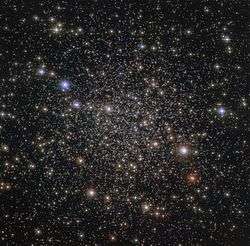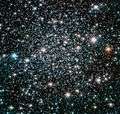NGC 6496
NGC 6496 is a globular cluster which is in the direction of the bulge and putative members of this subgroup, based on observations collected with the WFPC2 on board the Hubble Space Telescope. NGC 6496 was originally believed to be a member of the disc system of GC, but scientists questioned this classification. It was instead suggested that NGC 6496, together with two other clusters, NGC 6624 and NGC 6637, could be halo clusters with strongly inclined orbits. NGC 6496 lies in the Southern sky at RA=17:59:03.68 and Dec=-44:15:57.4.[6]
| NGC 6496 | |
|---|---|
 Processed Hubble image of the globular cluster | |
| Observation data | |
| Class | XII[1] |
| Constellation | Scorpius |
| Right ascension | 17h 59m 03.68s[2] |
| Declination | −44° 15′ 57.4″[2] |
| Distance | 36.9 kly (11.3 kpc)[3] |
| Apparent dimensions (V) | 5.6' |
| Physical characteristics | |
| Mass | 8.2×104[4] M☉ |
| Metallicity | = –0.70[5] dex |
| Estimated age | 12.42 Gyr[5] |
The first CMD presented of NGC 6496 had photometry reaching 2 mag below the horizontal branch, disclosing for the first time the usual red arm of the metal-rich clusters. The extinction towards NGC 6496 is uncertain, with estimates ranging between E(B-V) = 0.09 and E(B-V) = 0.24.[7]
Gallery
References
- Shapley, Harlow; Sawyer, Helen B. (August 1927), "A Classification of Globular Clusters", Harvard College Observatory Bulletin, 849 (849): 11–14, Bibcode:1927BHarO.849...11S.
- Goldsbury, Ryan; et al. (December 2010), "The ACS Survey of Galactic Globular Clusters. X. New Determinations of Centers for 65 Clusters", The Astronomical Journal, 140 (6): 1830–1837, arXiv:1008.2755, Bibcode:2010AJ....140.1830G, doi:10.1088/0004-6256/140/6/1830.
- Boyles, J.; et al. (November 2011), "Young Radio Pulsars in Galactic Globular Clusters", The Astrophysical Journal, 742 (1): 51, arXiv:1108.4402, Bibcode:2011ApJ...742...51B, doi:10.1088/0004-637X/742/1/51.
- Marks, Michael; Kroupa, Pavel (August 2010), "Initial conditions for globular clusters and assembly of the old globular cluster population of the Milky Way", Monthly Notices of the Royal Astronomical Society, 406 (3): 2000–2012, arXiv:1004.2255, Bibcode:2010MNRAS.406.2000M, doi:10.1111/j.1365-2966.2010.16813.x. Mass is from MPD on Table 1.
- Forbes, Duncan A.; Bridges, Terry (May 2010), "Accreted versus in situ Milky Way globular clusters", Monthly Notices of the Royal Astronomical Society, 404 (3): 1203–1214, arXiv:1001.4289, Bibcode:2010MNRAS.404.1203F, doi:10.1111/j.1365-2966.2010.16373.x.
- Richtler, T; Grebel, E (1994). "The cases of the "disk" globular clusters NGC 6496, NGC 6624, and NGC 6637". Astronomy and Astrophysics. 290: 412–420. Bibcode:1994A&A...290..412R.
- Armandroff, Taft E. (1988). "Color-magnitude diagrams for six metal-rich, low-latitude globular clusters". The Astronomical Journal. 96: 588. Bibcode:1988AJ.....96..588A. doi:10.1086/114833.
- "A heavy-metal home". Retrieved 30 May 2016.
